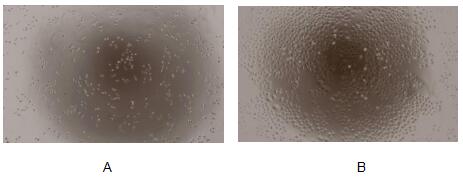Active Platelet Factor 4 (PF4)
CXCL4; SCYB4; Chemokine C-X-C-Motif Ligand 4; Oncostatin-A; Iroplact
- Product No.APA172Mu01
- Organism SpeciesMus musculus (Mouse) Same name, Different species.
- Buffer Formulation20mM Tris, 150mM NaCl, pH8.0, containing 1mM EDTA, 1mM DTT, 0.01% SKL, 5% Trehalose and Proclin300.
- TraitsFreeze-dried powder
- Purity> 90%
- Isoelectric Point9.4
- ApplicationsCell culture; Activity Assays.
- Download Instruction Manual
- UOM 10µg50µg 200µg 1mg 5mg
-
FOB
US$ 147
For more details, please contact local distributors!US$ 368
For more details, please contact local distributors! US$ 736
For more details, please contact local distributors! US$ 2208
For more details, please contact local distributors! US$ 5520
For more details, please contact local distributors!
ACTIVITY TEST of the Active Platelet Factor 4 (PF4)

Platelet factor 4 (PF4) is a small cytokine belonging to the CXC chemokine family that is also known as chemokine (C-X-C motif) ligand 4 (CXCL4). This chemokine is released from alpha-granules of activated platelets during platelet aggregation, and promotes blood coagulation by moderating the effects of heparin-like molecules. Due to these roles, it is predicted to play a role in wound repair and inflammation. To measure its ability to inhibit the FGF basic-dependent proliferation of HUVEC human umbilical vein endothelial cells, HUVEC cells were seeded into 96-well plates at a density of 3,000 cells/well with 2% serum standard DMEM including 1μg/mL recombinant human FGF1 and various concentrations of recombinant human PF4. After incubated for 48h, cells were observed by inverted microscope and cell proliferation was measured by Cell Counting Kit-8 (CCK-8). Briefly, 10µL of CCK-8 solution was added to each well of the plate, then the absorbance at 450nm was measured using a microplate reader after incubating the plate for 1-2 hours at 37℃. Proliferation of HUVEC cells after incubation with PF4 for 48h observed by inverted microscope was shown in Figure 1. Cell viability was assessed by CCK-8 (Cell Counting Kit-8) assay after incubation with recombinant human PF4 for 48h. The result was shown in Figure 2. It was obvious that PF4 significantly FGF basic-dependent proliferation of HUVEC cells. The ED50 is 3.4μg/mL.
(A)HUVEC cells cultured in DMEM with 1μg/mL FGF1, stimulated with 5μg/mL PF4 for 48h;
(B) Unstimulated HUVEC cells cultured in DMEM with 1μg/mL FGF1 for 48h.
Figure. Inhibition of HUVEC cells proliferation after stimulated with PF4.

Figure. Inhibition of FGF basic-dependent HUVEC proliferation after stimulated with PF4.
USAGE of the Active Platelet Factor 4 (PF4)
Reconstitute in 20mM Tris, 150mM NaCl (PH8.0) to a concentration of 0.1-1.0 mg/mL. Do not vortex.
STORAGE of the Active Platelet Factor 4 (PF4)
Avoid repeated freeze/thaw cycles. Store at 2-8°C for one month. Aliquot and store at -80°C for 12 months.
STABILITY of the Active Platelet Factor 4 (PF4)
The thermal stability is described by the loss rate. The loss rate was determined by accelerated thermal degradation test, that is, incubate the protein at 37°C for 48h, and no obvious degradation and precipitation were observed. The loss rate is less than 5% within the expiration date under appropriate storage condition.
INCREMENT SERVICES
BCA Protein Quantification Kit
Molecular Mass Marker for Protein
Monoclonal Antibody Customized Service
Polyclonal Antibody Customized Service
Protein Activity Test Experiment Service
Electrophoretic Mobility Shift Assay (EMSA) Experiment Service
Buffer
Lentivirus Packaging Experiment Service
Adenovirus Packaging Experiment Service
Real Time PCR Experimental Service
Spike RBD Protein (S-RBD)
Protein G
Protein A
Related products
| Catalog No. | Organism species: Mus musculus (Mouse) | Applications (RESEARCH USE ONLY!) |
| APA172Mu01 | Active Platelet Factor 4 (PF4) | Cell culture; Activity Assays. |
| RPA172Mu01 | Recombinant Platelet Factor 4 (PF4) | Positive Control; Immunogen; SDS-PAGE; WB. |
| RPA172Mu02 | Recombinant Platelet Factor 4 (PF4) | Positive Control; Immunogen; SDS-PAGE; WB. |
| PAA172Mu01 | Polyclonal Antibody to Platelet Factor 4 (PF4) | WB; IHC; ICC; IP. |
| PAA172Mu02 | Polyclonal Antibody to Platelet Factor 4 (PF4) | WB; IHC; ICC; IP. |
| LAA172Mu71 | Biotin-Linked Polyclonal Antibody to Platelet Factor 4 (PF4) | WB; IHC; ICC. |
| LAA172Mu81 | FITC-Linked Polyclonal Antibody to Platelet Factor 4 (PF4) | WB; IHC; ICC; IF. |
| SEA172Mu | ELISA Kit for Platelet Factor 4 (PF4) | Enzyme-linked immunosorbent assay for Antigen Detection. |
| SCA172Mu | CLIA Kit for Platelet Factor 4 (PF4) | Chemiluminescent immunoassay for Antigen Detection. |
| LMA172Mu | Multiplex Assay Kit for Platelet Factor 4 (PF4) ,etc. by FLIA (Flow Luminescence Immunoassay) | FLIA Kit for Antigen Detection. |
| KSA172Mu01 | ELISA Kit DIY Materials for Platelet Factor 4 (PF4) | Main materials for "Do It (ELISA Kit) Yourself". |

